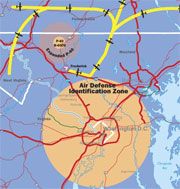 |
| Click to enlarge |
Pilots planning to attend AOPA’s Fly-In and Open House in Frederick, Md., this Saturday should be aware that the FAA plans to expand a nearby P-40 prohibited area during the fly-in time frame. The area will grow from a 3-nm radius to 5 nm. Pilots flying in the ring from 5 nm to 10 nm must be on an active IFR or VFR flight plan, maintain positive radio contact with ATC, and use an ATC-assigned discrete transponder code. Pilots who violate the airspace can expect to be intercepted by the U.S. Air Force and questioned by the U.S. Secret Service, and can expect enforcement action by the FAA, AOPA says. “By all means, come to Fly-In,” said AOPA President Phil Boyer, “but be very thorough in your pre-flight planning. Our goal is zero airspace incursions in spite of the challenges thrown our way.”
All pilots flying into or departing from Frederick Municipal Airport during the P-40 expansion (3 p.m. EDT, Friday, June 6 until 1 p.m. EDT, Sunday, June 8) should monitor the Guard frequency, 121.5 MHz. And as always, check Notams before each and every flight. “AOPA is already seeking ways to alleviate the issue,” said Andy Cebula, AOPA executive vice president of government affairs. “We are speaking directly with the FAA and security agencies to make sure they understand the potential trap they’ve created for Fly-In visitors.” AOPA is also using every communication avenue available to make pilots aware of the temporary flight restriction, including their Web site, e-mail alerts, alerts to every FBO and flight school in the region, and announcements on automated weather broadcasts.
In addition, the Civil Air Patrol has asked squadrons east of the Mississippi River to station members at airports on Saturday morning and ask pilots if they are headed to the Washington, D.C., area, and ensure they are aware of the expanded P-40 area. The FAA will operate a temporary air traffic control tower at Frederick Municipal Airport on Saturday. Arrival and departure procedures developed in conjunction with the FAA are available online. AOPA has also developed a graphic to show the correct arrival traffic flow to avoid the prohibited area. And finally, to be prepared in case a pilot accidentally violates the airspace restriction and picks up a fighter escort, the AOPA Air Safety Foundation has developed an intercept procedures card. “Early indications are that we’re going to have great weather this Saturday, so by all means, come,” said Boyer. “Just make sure you’re fully aware of the procedures and the restrictions. Let’s show the FAA and the security folks just how conscientious pilots really are.”
Click here for the FAA Notam.


































